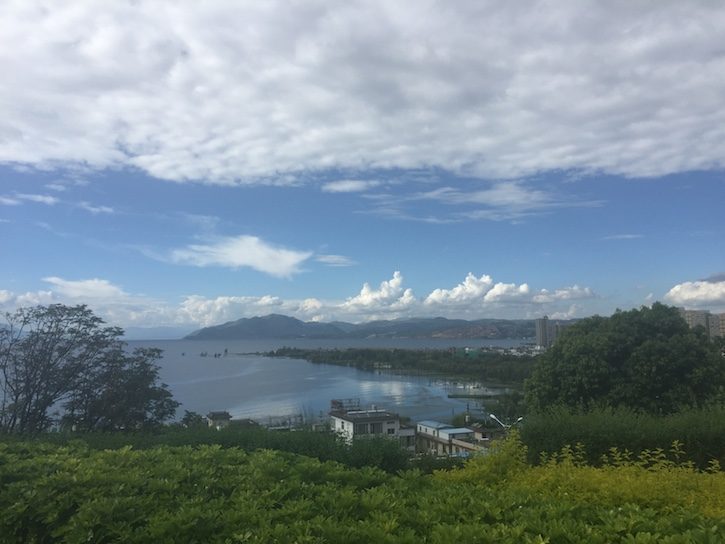
By Kevin Mo
It was a sunny day in August 2017 with a clear blue sky and white clouds drifting over the historic Southern Chinese city of Dali. Driving around Erhai Lake, we were amazed at vastness of the picturesque lake and the imposing Cangshan Mountain shrouded in clouds. Unfortunately, only a handful of tourists were visiting the lake that day, a sharp decline from the crowds it drew in previous years.
In the past, thousands of inns and restaurants were built around Erhai Lake to capitalize on its natural beauty. The sewage from these businesses was usually directly discharged into the lake. In addition, a large amount of chemical fertilizer and pesticide applied to the surrounding farmland flowed into the lake as runoff, seriously degrading the lake’s water quality. Large-scale algal blooms became regular occurrence. In April, the Dali Municipal Government issued an announcement that regulated the tourism industry in the main commercial center of the Erhai Lake Basin in order to improve environmental conditions. All the inns and restaurants in the area were asked to suspend operations until passing an inspection by the local environmental protection authority. As a consequence, tourism near Erhai Lake—which should now be in its peak season—has been reduced to a trickle.
Erhai Lake’s Dilemma
Erhai Lake is faced with a long-term dilemma. As a lake on the Yunnan-Guizhou Plateau, Erhai is the second largest freshwater lake in Yunnan, with a surface area of about 256km2 and a maximum depth of 20m. Nearly 800,000 locals rely on the lake for their drinking water. The lake’s water quality is categorized between Grade II and Grade III, much better than the water quality of Yunnan’s Dianchi Lake, which is worse than Grade V. Nonetheless, all of the sewage from the hotels, restaurants and car washing stations within the Erhai Lake basin has long been directly or indirectly discharged into the lake, and no facilities for pollution control have been put in place by the many tourism service providers.
Moreover, there are large areas of farmland and a number of livestock and poultry farms along the major rivers that flow into Erhai Lake. These non-point source pollutants (such as agricultural pesticides and chemical fertilizers) and livestock manure are highly concentrated. As a result, the water quality of many tributaries have become Grade IV or even Grade V before they flow into Erhai Lake. The long-term increase in pollution has rapidly increased the amount of nutrients in the water. Under certain circumstances, this may make it easier to trigger large-scale algal blooms in the lake. If no measures are taken to control this situation, Erhai Lake could easily become the next Dianchi Lake.
According to the website for the PPP (Public-Private Partnership) Center under China’s Ministry of Finance, since 2015 there have been seven large-scale PPP projects related to integrated environmental control in Erhai Lake. These projects are currently under construction or will begin construction soon. The total investment for these projects is nearly 13 billion RMB (about $2 billion US dollars). These projects include sewage collection around the lake, integrated treatment of river channels flowing into the lake, sewage collection and treatment, ecological restoration and wetland building in the lakeside buffer zone, and contiguous regulation of the rural environment. Although the government payment cycle for some projects reaches up to 20 years, the local government has launched a few environmental protection and control projects in Erhai with a total investment of 13 billion RMB within two years, indicating the strong political support the Dali Prefectural Government is giving to improve the local environment. Such spending poses a large fiscal pressure on the local government, which had a fiscal revenue of only about 15 billion RMB in 2016.
Despite their huge investment in environmental protection projects, local officials are still deeply worried about non-point source pollution in rural areas, and they have yet to find an appropriate solution to this challenge. While the PPP projects are mainly designed to improve Erhai Lake’s water quality, restore the wetlands, and better manage urban and rural domestic sewage, they fail to address the non-point pollution sources that have the most serious impacts on water quality in Erhai Lake: the excessive application of chemical fertilizers and pesticides in local rural areas. It is hard to tell, without first reducing the application of pesticides and chemical fertilizers in the surrounding rural areas, whether the 13 billion RMB investments in environmental projects can make the water quality of Erhai Lake meet the necessary standards.
Many policy makers tend to hesitate when it comes to addressing the non-point pollution problem in rural areas. It is difficult to change the long-term farming practices of Chinese farmers through the kinds of large-scale investment in engineering projects on which the government usually relies. Actually, this is a national problem. Over the past few years, trillions of RMB have already been invested in PPP projects related to water pollution control. However, few effective solutions have been found to address the non-point source pollution problem in rural areas. Most of the existing PPP projects focus on point source pollution. Typical projects include construction of sewage treatment plants, pipeline installations, industrial wastewater collection and treatment, river channel dredging, wetland restoration, and water landscaping. However, if the non-point source pollution problem in rural areas cannot be addressed, it is unclear to what extent these huge investments can help improve water quality and how long the outcomes can last.
Ironically, some PPP project developers building sewage treatment plants or laying pipelines are afraid that the sewage treatment fees paid by local governments as part of the PPP contract may decline sharply if the pollutant sources are controlled. Without sufficient amount of wastewater for treatment, the plants could see a drop in their revenue.
Garlic planting: the source of pollution?
Statistics from 2016 show that Yunnan Province is the largest home to state-level ‘poverty counties’ in China, with 73 counties falling under the category. The counties surrounding Erhai Lake, such as Eryuan, Jianchuan, Yangbi, Heqing and Midu counties, are all on the list and dominant by farmlands. Many farmlands are also within the state-designated permanent ‘farmland zones’, which means use of the lands can’t be changed. Alleviating poverty and helping local farmers increase income has become the priority of local officials as well.
Interestingly, Eryuan County, a state-level poverty county located at the upper reaches of Erhai Lake, is the only county in China growing single-clove garlic on a large scale due to its unique geographic location and climate. The single-clove garlic has both high nutritional and economic value. In recent years, the garlic has generated a net profit of more than 10,000 yuan per mu (about $9,300 per acre) for local farmers in Eryuan County. The leasing fee of garlic farmlands has risen to 5,000-6,000 yuan per mu, much higher than that of the farmland for other crops. Due to single-clove garlic planting, Eryuan County is expected to officially remove its poverty label soon.
But over-fertilizer to increase the yield of garlic has created serious environment problems. The amount of chemical fertilizers applied has reached nearly 200kg per mu. The high nitrogen and phosphorus content in chemical fertilizers has become the major contributors to eutrophication in Erhai Lake. Moreover, the pesticides with a high content of toxic residues are causing great damage to local environmental conditions. The local government may consider “taking resolute and determined measures”—as it has done to inns and restaurants surrounding the lake—to reduce or even abolish the garlic production in Eryuan County through a mandatory land transfer practice. Only in this way can the local area significantly reduce widespread non-point source pollution from overuse of fertilizers and pesticides and ensure that the water quality and environment in Erhai Lake are successfully improved and protected. But will the county return to poverty if it gives up its profitable garlic growing business?
Lucid waters and lush mountains are invaluable assets
Historically, Toyooka City, Hyogo Prefecture in Japan served as the habitat for wild Oriental White Storks (Ciconia boyciana), and was also one of the most famous rice production areas in Japan. Since the Meiji Restoration (1868-1912) when Japan began to develop into a modern society, the local farmers began to apply large amounts of pesticides and fertilizers so as to raise rice production and meet the growing needs for rice. As a result, the number of insects and frogs in the fields and surrounding wetlands declined sharply, and food sources for the wild Oriental White Storks gradually disappeared.
During the same period of time, most of the lands in Hyogo Prefecture suffered pesticide pollution, resulting in the gradual loss of rice paddy fields. In 1971, the last wild Oriental White Stork in Japan died, indicating the species became extinct in the wild in the country. Having drawn lessons from this bitter experience, Japan started to introduce the species from foreign countries and conducting artificial breeding. Meanwhile, Hyogo Prefecture also realized the importance of protecting the rural environment, moving to strictly limit the application of pesticides and fertilizers. Through three decades of conservation efforts, the wild habitats for Oriental White Stork have been restored, the streams have reappeared in rice paddy fields, and fish and shrimps are found swimming in ponds and swamps.
The first batch of Oriental White Stork was reintroduced to the wild in 2005. Two years later, the first baby bird was born in the wild. When the wild Oriental White Storks gradually returned to the paddy fields in flocks, the local people were pleasantly surprised to find the rice produced in these paddy fields has become more delicious, whose nutrition and flavor was much better than that in other rice production areas. Although the unit production of the rice was reduced due to non-application of fertilizers and pesticides, the quality of soil was significantly improved, resulting in higher prices for environmentally friendly rice, as well as the increase of incomes for local rice farmers. Hence the rice was named as “Oriental White Stork-friendly Rice”.
The idea that “rice grown in the paddy fields with Oriental White Storks is the most delicious” has been recognized by rice farmers in Japan. By restoring the local environment and changing the traditional planting practices, Toyooka City has abandoned its old habit of large-scale fertilizer application while highlighting that the ecological cultivation of rice can result in a higher quality and higher price. The new concept has brought prosperity and resources to the local people, while enabling them to enjoy clear rivers and green mountains again.
A balance between protecting Erhai Lake and producing garlic is possible
The Chinese central government’s No.1 Document in 2017 focused on the supply-side structural reform in agriculture, stressing the need to increase incomes of farmers, improve efficiency of agriculture and make the rural areas greener. Like industry, agriculture in China also urgently needs structural adjustment. China’s grain production has increased for 12 consecutive years. However, many high quality agricultural products still need to be imported from foreign countries. This is similar to the case in China’s steel industry: although its steel production ranks first worldwide, special functioned steel still relies heavily on imports. With the population growth and higher living standards in urban areas, demand for environmentally responsible food is increasing, and food safety has attracted increasing attention due to its importance.
China’s agriculture needs to change its traditional practice characterized by high production and low quality. Sustainable agriculture could help optimize the supply structure, improve environment, address climate change and increase farmers’ incomes. The key to achieving these objectives is to focus on soil health, change of farming practices, application of information technologies, and innovation in agricultural technologies.
In Dali, single-clove garlic—a native profitable crop that helps lift local farmers out of poverty—has been a primary target of blame for Erhai Lake’s pollution problem. Local policymakers are now faced with the dilemma of choosing between environmental protection and economic development. Is it possible to keep growing the native single-clove garlic with ecological planting that reduces pollution to the lake by cutting or even stopping the application of pesticides and fertilizers? Furthermore, can the incomes of garlic growers be increased under the new ecological planting practice? If the three objectives—environment protection, income increase and climate mitigation—could be achieved at the same time, wouldn’t it be a perfect show case of agricultural supply-side structure reform?
To explore the ecological planting practice of garlic in the Eryuan river basin, Beijing Goldenway Bio-tech (BGB) Company, the winner of the 2017 Paulson Prize for Sustainable Cities, has worked closely with the local Agricultural Technologies Promotion Center and other organizations to pilot the eco-farming practice of garlic in Eryuan County, where the Erhai Lake originates. Three major water systems flowing into Erhai Lake—Miju, Luoshi and Yong’an rivers—flow through the county. It is also a major area for planting garlic in the Erhai Lake basin.
To maximize garlic production, the local farmers have previously applied excessive amounts of fertilizers. The amount of fertilizers applied in each mu has reached nearly 200kg, well above the national average in China, and far exceeding the upper limit of 15kg per mu suggested by some developed countries trying to prevent over-application of chemical fertilizers from jeopardizing water safety. Moreover, Eryuan County is well known for its livestock and poultry production. Each year, approximately one million tons of livestock and poultry feces are generated, nearly 60 percent of which fail to be treated and are returned to farmlands for reuse. These pollutants, following rain leaching, flow into Erhai Lake with runoff transfer, diffusion, and infiltration, becoming one of the major sources of agricultural non-point source pollutants.
The Pilot Team investigated 60,000 mu of garlic farmlands in Eryuan County and found common problems: over-application of fertilizers; serious degradation of farmland soils; increasing pollution risks of heavy metals and pests due to application of untreated urines and feces; and imbalance of microorganisms in the soil ecosystem. According to reports, the annual loss of nitrogen and phosphorus in farmlands in northern Erhai Lake has become very serious.
The three rivers have become the most significant sources of pollution to Erhai Lake. The water quality of these three rivers was generally defined as Class IV and changed with the seasons. The total levels of nitrogen and phosphorus in the rivers increased during the period from October-December to January-March in the following year, and decreased or stabilized from May to August. This seasonal change exactly coincides with the garlic planting period, indicating that the pollution in the three tributaries are from garlic planting. Since the three rivers contribute 60 percent of the annual replenished water and 50 percent of the total nitrogen and phosphorus to Erhai Lake, their water quality undoubtedly have a major impact on the water quality of Erhai lake. In this sense, Eryuan County has become a key area for preventing and controlling pollutants from rivers that flow into Erhai Lake from the north.
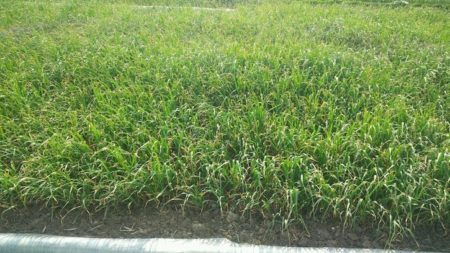
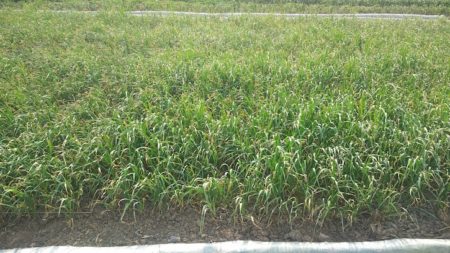
To further explore eco-agriculture planting and water and soil conservation in the Erhai Lake basin, BGB rented 51 mu of local garlic-growing farmlands to conduct experiments during the garlic planting season of 2016-2017. With the eco-planting principles of “substituting organic for chemical fertilizer, and biological pesticide and physical control for highly-toxic chemical pesticides”, comparative experiments and studies on two options (reduced application of chemical fertilizers and pesticides by 30%, or “planting with reduced discharge”; and zero-application of chemical fertilizers and pesticides, or “planting with zero discharge”) were conducted using the “biologically enhanced humus-based fermentation technology” that won the National Golden Prize of Patents and the National Award for Technological Invention. The experiments also used treated manure for garlic production, which is converted from local livestock and poultry feces in a cost-effective manner. Following the studies, it was concluded that:
- The per-unit production is evaluated based on cost-benefit analysis. The results showed that the per-unit profit goal can be reached under the two options.
- The content of garlicin, a major active nutrition in garlic, under the practice of planting with zero discharge and reduced discharge grew by 33% and 13% respectively, as compared to the traditional planting method. This means that the garlic under the two new planting methods has both a higher nutritional value and potentially a higher market price.
- The reduction of total nitrogen and phosphorus in water bodies under the practice of planting with zero discharge reached 78% and 74% respectively, while those figures under the practice of planting with reduced discharge were 55% and 53% respectively.
- If more than 200,000 mu of farmlands surrounding the three river basins take the practice of planting with zero discharge, and all the livestock and poultry feces across Eryuan County are reused in the farmlands after safe treatment, the water quality in the three tributaries can be improved from Class IV to Class II. Even if the practice of planting with reduced discharge is employed, the water quality can still be improved to Class III.
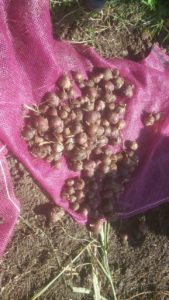

At the end of August 2017, five Japanese experts on garlic planting were invited by BGB to visit Dali. These Japanese experts, together with leaders from the Agriculture Bureau of Jinxiang County in Shandong Province, where the National Garlic Trading Center is located, and experts from the Garlic Research Institute under the Science and Technology Commission of Jinxiang County, gathered in Eryuan County to hold a two-day workshop on transforming local garlic planting into an eco-agricultural practice. The participants agreed that the single-clove garlic in Eryuan County has a great potential in helping reduce discharge of pesticides and fertilizers, while studies should be enhanced and ecological planting practices should be promoted for other crops (e.g., alpine vegetable, pear, grape and walnut). If ecological planting practice can be fully implemented in the agricultural counties around Dali, the agricultural non-point source pollutants will be significantly reduced, and the water quality in Erhai Lake will be significantly improved.
To fully promote ecological planting practices, however, many issues need to be addressed. It’s more than simply stopping the application of pesticides and fertilizers. Eco-farming requires innovation and support of husbandry techniques, soil testing and data analysis, etc. Public awareness and demonstration also play a crucial role in promoting ecological planting practices, as most farmers are unwilling to take the risk of trying a new planting practice. Meanwhile, the large-scale development of eco-agriculture is not possible without many key factors such as the farmland transfer mechanism, pricing mechanism of quality products, supply chain of organic food processing industry, soil testing and nutrition plans, promotion of farm machinery, organic fertilizers standards, water-conservation, and e-commerce of agricultural products.
It should be noted that sustainable cities in China depend heavily on sustainable agriculture—like two sides of a coin—the two are inseparable from each other. Many biological and safety needs, such as safe food and clean drinking water, cannot be made available for cities without a clean rural environment.
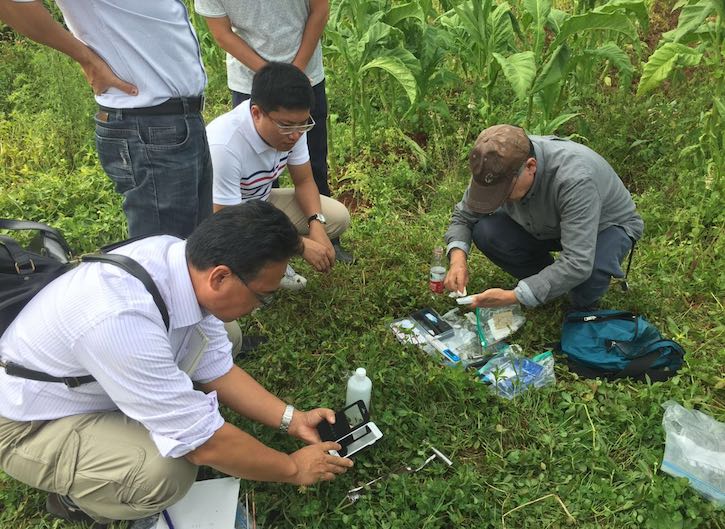
The experiments in Eryuan County have provided valuable ideas and inspiration on how to balance economic development and environmental protection. While helping protect clear rivers and green mountains, eco-agriculture can help improve the quality of local crops and enable local farmers increase their incomes, lifting themselves out of poverty.


